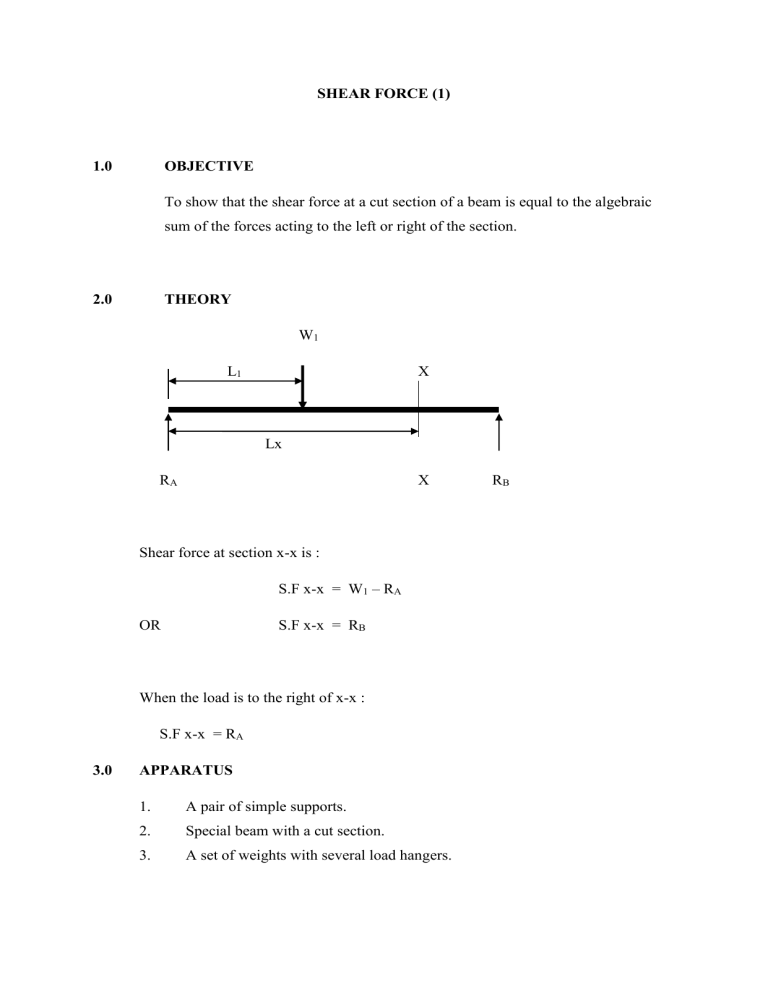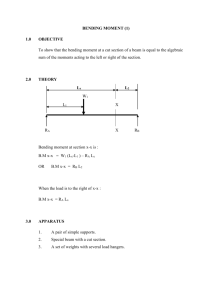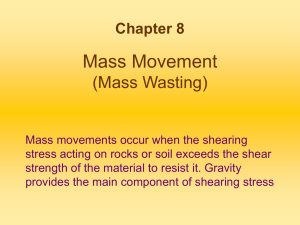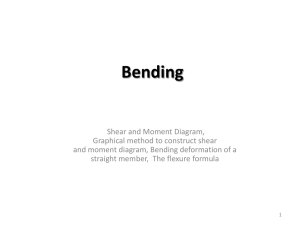ddpa 2052 – shear force

SHEAR FORCE (1)
1.0 OBJECTIVE
To show that the shear force at a cut section of a beam is equal to the algebraic sum of the forces acting to the left or right of the section.
2.0 THEORY
W
1
R
A
L
1
Lx
X
X
Shear force at section x-x is :
S.F x-x = W
1
– R
A
OR S.F x-x = R
B
When the load is to the right of x-x :
S.F x-x = R
A
3.0 APPARATUS
1.
A pair of simple supports.
2.
Special beam with a cut section.
3.
A set of weights with several load hangers.
R
B
4.0 PROCEDURE
1.
Connect the load cell to the digital indicator.
2.
Switch on the indicator. For stability of the reading the indicator must be switch on for 10 minutes before taking readings.
3.
Fixed the two simple supports to the aluminum base at a distance equal to the span of the beam tested. Screw the supports tightly to the base.
4.
Hang the load hanger to the beam.
5.
Place the beam on the supports.
6.
Place the load hanger at the desired location.
7.
Note the indicator reading. If it is not zero, press the tare button on the indicator.
8.
Place a load on each load hanger.
9.
Record the indicator reading. This represents the shear force at the cut section.
10.
Add load to the load hanger and record the indicator reading.
11.
Repeat step 10 for another 5 sets of readings.
5.0
Table 1
RESULTS
Beam span
= ………………….mm
Distance of the shear section from the left support, Lx
= ………………….mm
Distance of the load from the left support, L
1
= …………………..mm
Load (N)
Shear force at x-x
Experimental (N) Theory (N)
6.0 QUESTIONS
1.
Using the data in Table 1, plot the bar chart for the shear force versus load.
2.
Determine the slope of the graph.
3.
Calculate the theoretical slope.
4.
From the slope, calculate the average percentage error for the experiment.
Percentage error = [(Slope theory – Slope exp.) / (Slope theory) ] x 100%
5.
Comment on the accuracy of the experiment
SHEAR FORCE ( 2 )
1.0 OBJECTIVE
To show that shear force at a cut section of a beam is equal to the algebraic sum of the forces acting to the left or right of the section.
2.0 THEORY
L
3
L x
L
1
L
2
W
1
W
2
W
3
R
A
OR
Shear force at section X – X is :
S.F x-x = W
1
+ W
2
+W
3
– R
A
S.F x-x = R
B
X
X
L
4
3.0 APPARATUS
1.
A pair of simple supports
2.
Special beam with a cut section
3.
A set of weights with several load hangers
R
B
4.0 PROCEDURE
1.
Connect the load cell to the digital indicator.
2.
Switch on the indicator. For stability of the reading, the indicator must be switch on for 10 minutes before taking readings.
3.
Fixed the two simple supports to the aluminum base at a distance equal to the span of the beam tested. Screw the support tightly to the base.
4.
Hang the load hanger to the beam.
5.
Place the beam on the supports.
6.
Place the load hanger at the desired location.
7.
Note the indicator reading. If it is not zero, press the tare button on the indicator.
8.
Place a load on each load hanger.
9.
Record the indicator reading. This represents the shear force at the cut section.
10.
Remove all loads from the load hangers and apply a different set of loading and at different set of locations.
11.
Repeat step 6 to 11 for another 5 sets of readings.
5.0 RESULTS
Beam span
= ……………………..mm
Distance of the shear section from the left support = …………………… mm
Table 2
Load case
Case 1
Case 2
Case 3
Case 4
Case 5
Load and its distance from the left support
W1 (N) L1(mm) W2 (N) L2(mm) W3 (N) L3(mm)
Shear force theory
(N)
Shear force experiment
(N)
% error
6.0 QUESTIONS
1.
Using the data in Table 2, plot the bar chart for the shear force for the theoretical and experimental case for each load case.
2.
Calculate the percentage error for each load case and hence determine the overall percentage error.
3.
Comment on the accuracy of the experiment.
4.
State the probable factors that affect the accuracy of the experiment.
5.
What is the importance of shear force in civil engineering area?
No.
1.
2.
3.
I/C No.
Section / Group
Lecturer’s Name
Item
Introduction
Objective
Equipment
Theory
Procedures
Data / Table
Data Analysis / C.P / Graph
Results of Experiment
Discussions
Conclusion
Suggestions / Comments
Reference / Attachment
Total
CIVIL ENGINEERING DEPARTMENT
SHEAR FORCE
Mark
25
35
35
5
100
Name
20
10
5
5
100
10
15
10
Mark
2
5
5
5
8
Mark








![Preferred Option [see pages XX]](http://s3.studylib.net/store/data/009487380_1-35fb3da55f0c53ba847983686aa982af-300x300.png)